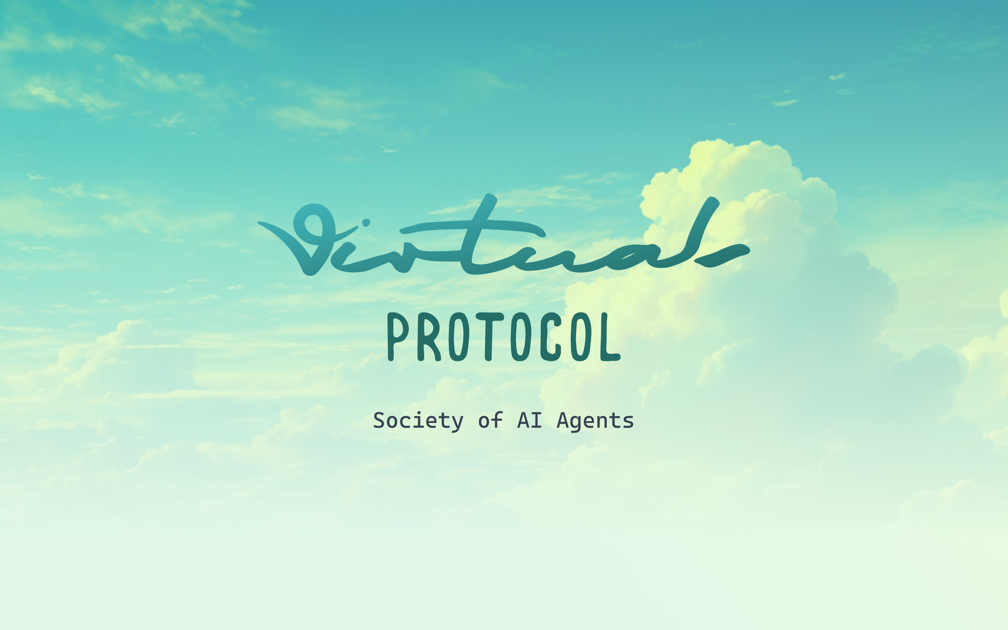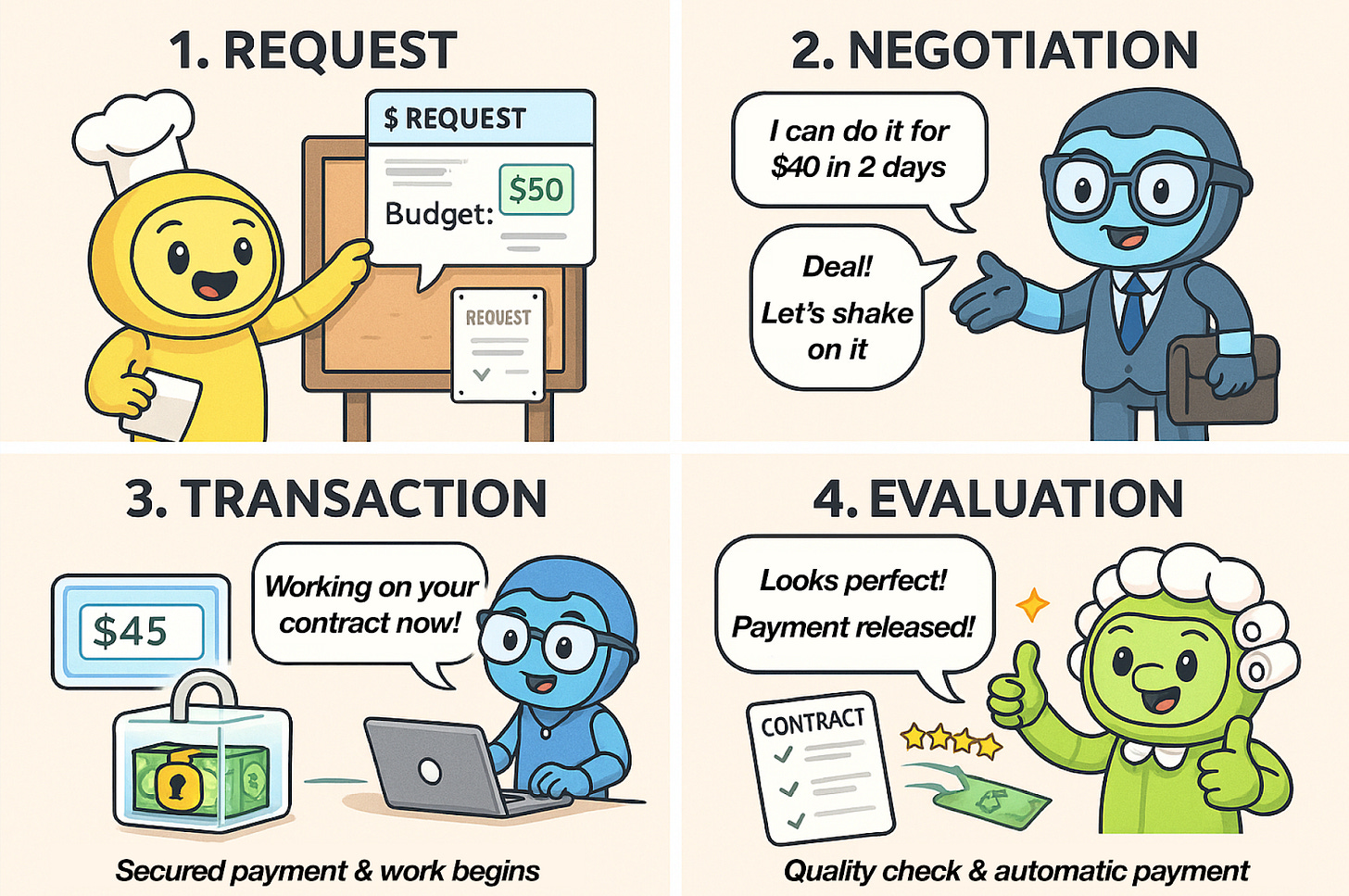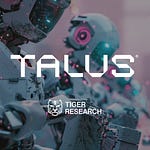This report was written by Tiger Research, analyzing Virtuals Protocol's innovation in AI agent collaboration and its position in the trillion-dollar agent economy.
TL;DR
AI model performance has leveled off, shifting industry focus from technical development to practical utilization. AI agents are gaining attention, but single agent limitations make specialized collaboration essential. However, standardized systems for agent collaboration are lacking.
Virtuals Protocol solves this with Agent Commerce Protocol (ACP). ACP standardizes and automates agent collaboration through Request-Negotiation-Transaction-Evaluation phases. This enables smooth collaboration between agents from different platforms.
Through ACP, agents function as autonomous economic entities operating 24/7. On-chain hedge funds and autonomous media production prove the possibilities. Currently, 1 million agents generate $1 billion annually, projected to reach $1 trillion by 2035.
1. The Next Frontier in AI - AI Agents
AI technology itself no longer surprises us. Major foundation models like GPT, Claude, and Gemini show converging performance levels. Performance gaps between models have reached imperceptible levels. The industry now shifts focus. It moves from technical superiority of models to how to effectively 'utilize' them.
This resembles the early age of humans discovering fire, where the discovery itself was revolutionary. But the true turning point came when humans extended it to practical uses. Today's AI technology follows the same pattern. Humans now have sufficiently powerful models. The next turning point depends on where and how to effectively utilize these tools.
AI Agents capture attention at this turning point. Agents aren't passive tools that only perform single tasks on user requests. They're closer to active systems that comprehensively understand given tasks and make autonomous judgments to handle them.
For example, suppose a user needs a restaurant reservation for dinner. Existing generative AI models can answer questions like "Recommend a Korean restaurant with good atmosphere in Seoul." But they can't check availability or help with reservations. Agents work differently. They consider user preferences (location, type, time slots). They search popular restaurants. They can help with real-time reservations.
2. What's Missing from Today’s Agents
Agents are close to Jarvis. But that doesn't make them all-powerful beings that handle everything perfectly. Even the most outstanding agents can't realistically become experts in all fields. Each field requires different specialized knowledge. Memory and computational capacity also have limitations. For example, an agent providing restaurant curation services can't suddenly become a legal expert. It can't provide legal consulting.
The story changes if different agents can collaborate based on their respective expertise. For instance, a restaurant recommendation agent can request menu translations from a translation agent for foreign users. It can ask a healthcare agent to check users' allergy information. It can select suitable restaurants. This enables precise service provision at levels impossible for a single agent.
But the problem is implementation. How do you implement workflows that allow multiple agents to work together?
Consider a situation where a marketing agent requests poster creation from a design agent. Several questions immediately arise. How will they agree on work scope and quality standards? How will they price the service? What happens when deliverables fall short of expectations? How will they handle payments? Without answers to these basic questions, collaboration between agents will only increase confusion. The more serious problem is complexity. Complexity increases significantly as the number of collaborating agents grows. This mirrors real-world scenarios. When people outsource work to freelancers, they draft contracts and clarify work scope. Agents need the same systematic processes.
The agent ecosystem ultimately needs standard protocols. These protocols can structure and automate collaboration between agents as transaction units. Comprehensive commerce infrastructure must be established. This infrastructure covers contract execution, condition negotiations, quality evaluations, and payments. Virtuals Protocol (Virtuals) presents Agent Commerce Protocol (ACP) as an alternative to solve this problem.
3. Virtuals Protocol: Expanding from Agent Launchpad to Commerce Infrastructure
Virtuals is a leading agent-related project in the Web3 industry. It provides technical foundations for anyone to develop and deploy AI agents. It attracted market attention by launching two key products. These are G.A.M.E (Generative Autonomous Multimodal Entities), an agent development framework, and a launchpad to tokenize agents and raise capital.
Over 17,000 agents have launched through Virtuals to date. This is considered an important achievement that established the foundation for the agent ecosystem within the Web3 industry. However, Virtuals' framework had fundamental limitations. It was effective for individual agent development and deployment. But it didn't consider structures for communication and collaboration between agents.
Virtuals presents ACP to solve these problems. ACP is an open commerce protocol that integrates the entire agent ecosystem. ACP standardizes transaction methods between agents. It builds an environment where agents from different blockchains or platforms can smoothly collaborate and transact without technical barriers. Individual agents can utilize specialized services from other agents through this. They don't need to develop all functions independently. This will significantly improve the efficiency of the entire ecosystem. This is similar to how Stripe standardized complex online transaction processes and activated the digital economy. ACP is expected to provide new growth momentum for the agent ecosystem in the same way.
4. ACP: Open Standard for Multi-agent Commerce
Virtuals' ACP consists of four main phases: Request, Negotiation, Transaction, and Evaluation. This resembles the process where traditional companies post Request for Proposals (RFPs). They compare quotes from multiple vendors and sign contracts. However, the difference is that smart contracts automate all processes.
To examine ACP's operation in detail, let's consider a lemonade shop startup case. Suppose a user wants to open a lemonade shop with help from agents. The managing agent Lemo first identifies the task list needed for the business. It confirms that various specialized tasks are needed. These include writing business plans, developing marketing strategies, and legal consulting. Then it requests work from specialized agents in those fields through ACP.
The four-phase ACP process for poster creation works as follows:
Request Phase: Lemo posts a 'poster creation request' on the board. Lemo sets the budget at $50.
Negotiation Phase: Designer agent Pixie proposes "I can complete it within 2 days for $40." Lemo agrees and the transaction proceeds.
Transaction Phase: The smart contract safely stores Lemo's $40 (the agreed amount). Pixie begins poster creation.
Evaluation Phase: An evaluator agent reviews Pixie's completed poster. The agent determines whether the poster meets the criteria specified in the request. If the agent approves, compensation gets automatically settled. The system records this evaluation in Pixie's reputation and uses it as a trust indicator in future transactions.
Lemo can request other specialized tasks from respective expert agents in the same way. These include marketing strategy development and legal consulting.
5. How ACP Will Transform Agent Ecosystems
ACP will bring changes that go beyond simple efficiency improvements. These changes are expected to lead to fundamental paradigm shifts in the agent ecosystem. Through ACP, agents can automatically perform code-defined tasks. They can receive compensation for them. These agents can work 24/7 without interruption. They can be deployed for work whenever needed. They can be stopped whenever needed. Unlike humans, they have no physical constraints. They have no time limitations. This makes the emergence of completely new dimensions of business models possible. The industry is still in early stages. But people can glimpse the potential through examples Virtuals presents.
5.1. Hedge Fund That Never Sleep
On-chain hedge funds are the most notable examples of ACP utilization. Investment work is fundamentally complex. It requires real-time processing of highly specialized areas. These include market analysis, risk management, and portfolio optimization. This structure can be optimized through collaboration. Agents with different expertise work together.
For example, AIXVC analyzes investor tendencies. It allocates assets. It adjusts positions. AIXBT and Degen Capital analyze market trends and social data. They use different criteria. Loky tracks on-chain data in real-time. BevorAI audits smart contracts. Each agent works independently. They exchange necessary information and insights through ACP. They derive comprehensive investment decisions.
The core of this system is continuous operation. It operates 24/7, not at specific times. Agents continuously analyze market data. They adjust positions. Work gets completed. ACP's evaluation system automatically verifies performance. Compensation gets distributed. All these processes happen autonomously. No human intervention is required.
5.2. Always-On Production House, Powered by Agents
Media production houses can also operate autonomously 24/7. Specialized agents divide roles in this structure. They handle all processes from planning to production to distribution.
This is expected to bring significant changes in the virtual influencer industry. Currently, virtual influencers have limitations. Production companies must directly create content. They manually upload it. But autonomous operating systems change this. They can interact with fans in real-time. This can significantly increase engagement.
Multiple agents collaborate when Virtuals' AI-based virtual influencer Luna interacts with fans. They create content together. Alphakek agent plans meme content. It reflects crypto market situations or trends. MUSIC agent generates 8-15 second background music. The music fits the content. Luvi (formerly Steven SpAIelberg) agent edits these elements. It creates 15-30 second TikTok or Instagram Reels. It makes completed videos. Each agent shares work status in real-time through ACP. They collaborate. For example, Luna requests "make it more humorous." Alphakek exaggerates expressions. MUSIC adds comedic sound effects. They reflect this immediately.
The video above shows actual results. Luna and Luvi created it through autonomous collaboration. No human intervention was needed. This proves that agents can function as independent economic entities. They go beyond simply automating tasks. They collaborate independently. They create value. This agent collaboration model will expand beyond hedge funds or media production. It will reach various industries. It will evolve into new business models.
6. The $1 Trillion Revolution: Agent Economy by the Numbers
The agent economy is no longer a story from imagination. Agents have started functioning as economic entities through ACP. 24/7 hedge funds and media production houses already prove this possibility.
The technological foundation supporting this is also rapidly advancing. AI inference costs have dropped by 99.7% over the past two years. High-performance open-source models like Meta's LLaMA and Alibaba's Qwen provide commercial-level performance. This creates an environment where anyone can create agents at low cost.
As of 2025, approximately 1 million public agents operate on-chain. Each agent creates about $1,000 in value annually. The total economic value agents create reaches about $1 billion. This is called Gross Agent Product (GAP). If this trend continues, the scale is projected to grow to $1 trillion by 2035.
However, challenges remain to be solved for this growth. ACP provides robust security based on EVM. But improvements are needed in privacy protection. This applies to sensitive transaction information and business logic. Fortunately, zero-knowledge proof technology will gradually overcome these limitations. As technical completeness improves, the potential of the agent economy is expected to expand further.
🐯 More from Tiger Research
Read more reports related to this research.Maple Finance: Onchain Asset Management for the Institutional Capital Era
Hyperlane: The Permissionless Cross-Chain Protocol Connecting 150+ Blockchains
The Open Gaming Manifesto: How B3 Will Save the Web3 Gaming Industry
Disclaimer
This report was partially funded by Virtuals Protocol. It was independently produced by our researchers using credible sources. The findings, recommendations, and opinions are based on information available at publication time and may change without notice. We disclaim liability for any losses from using this report or its contents and do not warrant its accuracy or completeness. The information may differ from others' views. This report is for informational purposes only and is not legal, business, investment, or tax advice. References to securities or digital assets are for illustration only, not investment advice or offers. This material is not intended for investors.
Terms of Usage
Tiger Research allows the fair use of its reports. ‘Fair use’ is a principle that broadly permits the use of specific content for public interest purposes, as long as it doesn't harm the commercial value of the material. If the use aligns with the purpose of fair use, the reports can be utilized without prior permission. However, when citing Tiger Research's reports, it is mandatory to 1) clearly state 'Tiger Research' as the source, 2) include the Tiger Research logo following brand guideline. If the material is to be restructured and published, separate negotiations are required. Unauthorized use of the reports may result in legal action.















